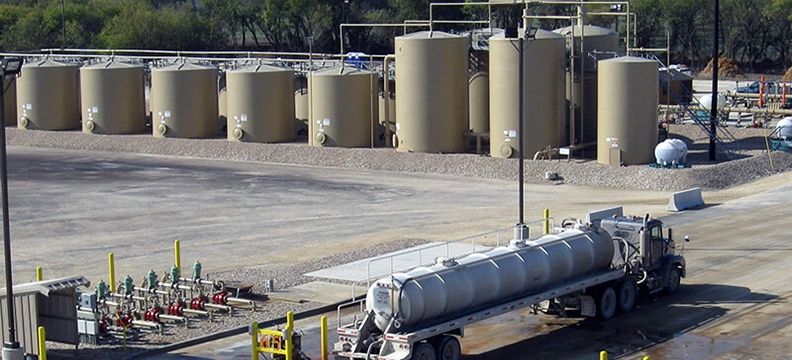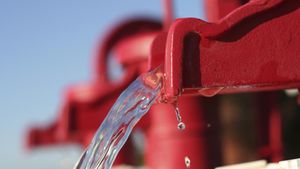Discover the basics of the oilfield water and its midstream business.
Oilfield water, usually at the backseat of the portfolio of critical risks, has been part of the energy upstream business since its early days. For as long as we’ve flown oil and gas, water has been a by-product.
But amid the leaps and bounds created by the extraordinary growth of U.S. shale production a decade or so ago, one of the few things that has remained constant is that oil and water don’t mix. This held true even as water’s role has evolved at a rapid pace, swelling to a mammoth daily volume of +50 million barrels.

An ever-growing portion of the saltwater –as it's commonly known- is generated during the hydraulic fracturing process. Unconventional wells need "fracking" to produce. This process consist of pumping high volumes of fluid containing water, chemicals, and proppant (primarily sand) into the petroleum reservoir, which holds open the newly created fractures and improves production.
To illustrate the demand change, we only need to look back to 2010, which in oilfield time feels like yesteryear. At the time, the completion of a typical horizontal well required roughly 75,000 barrels of water. Today, a horizontal well completion calls for more than 600,000 barrels. Multi-well pads need more than 5 million barrels of water.
Up to 50% of the fluids pumped during the fracking process returns as flowback water during the first 4-6 weeks of production. A large percentage of the remainder, plus pre-existing formation water, is recovered as produced water over the life of the well.
But not all reservoirs are the same, which is also true for shale; oil-bearing formations have a higher “water cut," or a water-oil ratio (WOR). Take the oil producing Permian Basin in west Texas and southeastern New Mexico, where on average for every 6 barrels of water, 1 barrel of oil is produced. Conversely, the gas-producing Marcellus shows as little as 0.2 barrels of water for 1 boe.
But even the stark Permian average hides an underlying issue. Water cut not only varies from basin to basin, but even within the same basin. For instance, in the Delaware (sub)basin, west of the Permian, as much as 10 barrels of saltwater are produced for every barrel of oil. Meanwhile, in the Midland (sub)basin, east of the Permian, the average is a mere three barrels of saltwater.
With the Permian dominating oil production, this amounts to an staggering volume of saltwater, every day. The data (see next Figures coming from the smart folks of Sourcewater, Inc.) clearly shows that horizontal drilling began the shift from 2010, but the trend kicked into high gear as the shale formation known as the Wolfcamp began its development since 2013.

As the volume increased, the initial response was to throw trucks at the problem, adding to the already intense traffic. However, trucks aren’t enough at scale. This was the painful experience by 2016 in the Marcellus -though it was similar in other Basins- when trucks had to line up at the gates of new wells and wait for hours. Costs then skyrocketed to ~10 dollars per each barrel of oil produced, while drivers had to find ways to other alsStates, Ohio and West Virginia, to offload the saltwater because the state of Philadelphia only had 8 active saltwater disposal (SWD) wells - currently 10.
This wasn’t bad after all because it prompted operators and service providers to achieve breakthroughs in water recycling: In recent years, over 90% of water is recycled in the Appalachian Basin. It wasn’t so long ago that producers believed they needed fresh water for hydraulic fracturing. Now they can almost use produced water with very little treatment; just remove solids, kill biologic components, and generate clean brine. Indeed, there's value in water.
But recycling has never taken off in other shale plays primarily because SWD wells are readily available; only in Texas, there are over 8,100 saltwater disposal wells. As a result, ~85% of the produced water is tossed downhole even if the economics of recycling are now attractive at scale. It’s easier to dispose than to treat, store, and transport huge volumes of water. In addition, the abundance of disposal sites allow for low reinjection costs, falling in the range of $0.05-1.65/bbl depending on location, transportation distance and whether the SWD is producer-owned or third party-operated.
The following chart follows the predominant paths that a barrel of water flows in the oilfield.

Water was traditionally handled by the E&Ps themselves: Many large operators ended up constructing their own water midstream systems; smaller ones were simply buying fresh water from ranchers and paying local companies to store and truck spot volumes of produced water to nearby SWD wells. In other words, just as gathering, transportation, and storage caught up with major oil infrastructure bottlenecks, water management infrastructure also had a drastic evolution.
With the massive disposal volumes, there was value to be captured in gathering, treating, selling, and disposing oilfield water for multiple E&Ps. This eventually led to the emergence of a midstream water business, in some cases with minimum volume commitment contracts and acreage dedications. What was long the purview of oilfield service and E&P companies was then transformed in a new breed of large regional and national water midstream companies, especially in the Permian Basin (see next Figure).

An estimated $9 billion to $11 billion of private capital has been committed to the oilfield water midstream business to 2020, and a further $16 billion is projected to be required. Its value hinges on the ability to provide reliable underground water-storage capacity while avoiding seismic events and potential aquifer contamination, both of which have been linked to produced water.
Water midstream providers resemble E&Ps in many ways. Both own, operate, and maintain wells, albeit shallower injection wells on the water side. E&Ps and water midstream companies must also track produced volumes, monitor production trends, prevent well downtime, and respond to issues in the field. As a midstream company, these service providers also share common business challenges with companies that gather, transport, and store oil. They share similar needs to attract and compete for contracts, accurately perform accounting and invoicing, and manage right of way ahead of planned infrastructure.
On Risks
But managing produced water is a dirty business. In essence, it is ancient seawater ~10-15x saltier than the water in our oceans today. In addition, exposure to deep rock introduces heavy metals and naturally occurring radioactive material (NORM). To make matters worse, oil-water separation is never 100% effective: On average, there are 4.5 barrels of oil for every 1,000 barrels of water processed at an SWD facility (~0.45% skim oil), and even higher if water is trucked.
By and large, the availability of combustible materials make fire a constant risk in SWD facilities, as shown in the following pictures.



There is much more -much more- one could say on the subject, but I don’t want to spill all the beans on SWD, any more than you want to read about, so let’s leave it at this for now: SWD has been one of the few growth markets in upstream energy in the past few years. Because it’s hard to treat and recycle, a water midstream business eventually emerged. It goes without saying, though I’m happy to say it, that very few risks markets are as distressed as saltwater disposal these days. One should also note that it's easy to separate oil from water, but impossible to separate oil from politics!
Share, follow, stay tuned for more!

